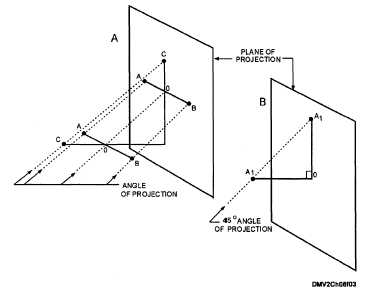Oblique Projections, Continued
Selecting a
Only one surface of the object can be parallel to the picture plane and
surface
represented in its true size and shape.
Place the surface with the irregular
outline or contour (curved or circular features) parallel to the picture plane or
place the longest dimension of the object parallel to the picture plane. If the
object is such that the surface with the longest dimension conflicts with the
irregular surface, always place the irregular surface parallel to the picture
plane.
This procedure minimizes distortion in the projected image.
Direction of the
Line lengths projected in oblique projection are determined by the angle of
projectors and
the projectors to the plane of projection. Projectors that angle 45° to the
line length
plane of projection project lines perpendicular to the plane of projection in
true length. When the angle of the projectors is greater, the line projected is
shorter. When the angle of the projectors is smaller, the projected line is
longer. Theoretically, any line perpendicular to the plane of projection could
project any length from zero to infinity. Any line parallel ‘to the plane of
projection will project in true size.
Figure 6-3 shows line length relative to the angle of the projectors.
Figure 6-3.—Line length: A. Lines parallel, and B.
Lines perpendicular to the plane of projection.
Continued on next page
6-5

